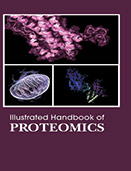Agriculture and Life Sciences

Protein, highly complex substance that is present in all living organisms. Proteins are the polymers of amino acids. Proteomics deals with the study of proteins on a genome-wide scale. Within the wide field of functional OMICS, proteomics has become a useful tool. Proteomics helps in understanding of change in protein expression during different stages of life cycle or under stress condition. Likewise, Proteomics helps in understanding the structure and function of different proteins as well as protein-protein interactions of an organism. A minor defect in protein structure, its function or change in expression pattern can be easily detected using proteomics studies. This is important with regards to drug development and understanding various biological processes, as proteins are the most favorable targets for various drugs.
Illustrated Handbook of Proteomics covers the broad microbiological applications of proteomics and mass spectrometry. It is focused on different types of techniques for the analysis of expressed proteins. It is also concentrated on applicative perspective of proteomics in the fields of biomedical, agriculture and food. There are several complementary tools available for proteome analysis including 2D protein electrophoresis and mass spectrometry. Emerging technologies for proteome analysis include spotted-array-based methods and microfluidic devices. Taken together, these technologies provide a wealth of information that is useful in discovery-based science. However, there are some key limitations of these approaches and new technology is required to be able to fully integrate proteomic information with information obtained about DNA sequence, mRNA profiles and metabolite concentrations into effective models of biological systems.
This Illustrated Handbook of Proteomics covers the multi-disciplinary topics of structural and functional biology, protein chemistry, cell biology, methodology used for protein analysis, including mass spectrometry, protein arrays, bioinformatics, etc.
The completion of genome sequencing projects and the improvement of methods for protein characterization surges this action forward. Presently, the usage of proteomics is being extended to analyze the different features of proteins including the activities structures, and protein-protein interactions. To use proteomics in real everyday clinical practice it is necessary that the biological material where such marker would be analyzed is easily accessible (blood, urine, salive, cereblospinal fluid). The other way to use proteomics is mainly within the experiment one of the emerging applications is in the field of therapeutical drug discovery and pharmacoproteomics.
This illustrated text will be of particular interest to students, including those involved with relevant technologies such as electrophoresis and mass spectrometry, to those interested in how proteomics can benefit research.